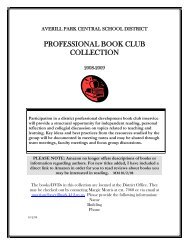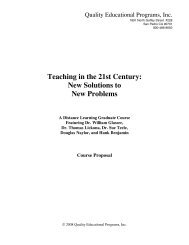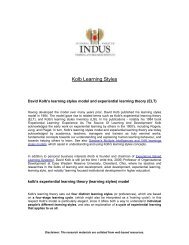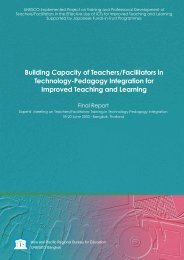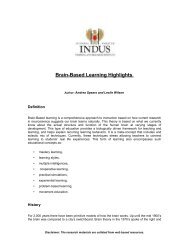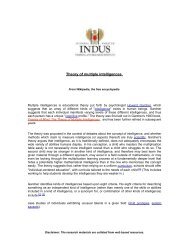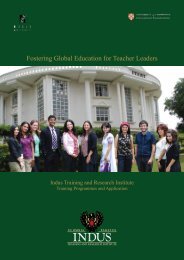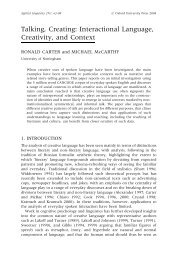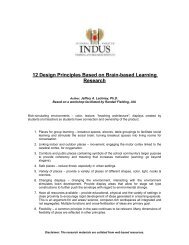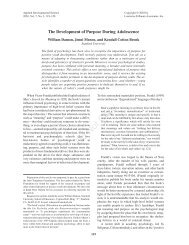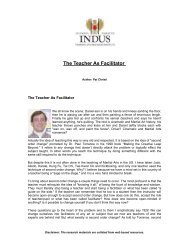Primary Years Programme Making the PYP happen - ITARI
Primary Years Programme Making the PYP happen - ITARI
Primary Years Programme Making the PYP happen - ITARI
- No tags were found...
Create successful ePaper yourself
Turn your PDF publications into a flip-book with our unique Google optimized e-Paper software.
<strong>Making</strong> <strong>the</strong> <strong>PYP</strong> <strong>happen</strong><br />
Understanding <strong>the</strong> <strong>PYP</strong><br />
from analysis to syn<strong>the</strong>sis<br />
The preceding sections of this publication present an analysis of <strong>the</strong> various components of <strong>the</strong> <strong>PYP</strong><br />
approach to curriculum. However, in order to understand fully <strong>the</strong> <strong>PYP</strong> it is important to see this approach<br />
as a syn<strong>the</strong>sis of <strong>the</strong>se components. This syn<strong>the</strong>sis operates at several levels.<br />
A syn<strong>the</strong>sis of <strong>the</strong>:<br />
essential elements:<br />
written, taught and learned<br />
curriculum:<br />
separate disciplines into a<br />
coherent whole:<br />
school into an international<br />
community of learners:<br />
Teachers and students use powerful concepts to generate key<br />
questions with which to conduct inquiry into significant content. In<br />
<strong>the</strong> course of this inquiry students acquire essential knowledge and<br />
skills and engage in responsible action. They do so in a climate<br />
which fosters positive attitudes. In <strong>the</strong> course of planning and<br />
teaching, <strong>the</strong> essential elements are syn<strong>the</strong>sized into key questions<br />
which drive inquiry, and into <strong>the</strong> learning outcomes which form <strong>the</strong><br />
basis for assessment.<br />
Using <strong>the</strong> written curriculum as <strong>the</strong> primary resource, teachers and<br />
students plan a process of structured inquiry involving a range of<br />
classroom activities—<strong>the</strong> taught curriculum. Assessment, which<br />
provides data on <strong>the</strong> learned curriculum, is integral to <strong>the</strong>se<br />
activities and focuses on both <strong>the</strong> quality of <strong>the</strong> learning process and<br />
that of <strong>the</strong> learning products.<br />
At <strong>the</strong> heart of <strong>the</strong> <strong>PYP</strong> curriculum are <strong>the</strong> essential elements:<br />
concepts, knowledge, skills, attitudes and actions. These elements<br />
transcend disciplinary barriers and forge <strong>the</strong> curriculum into a<br />
coherent whole.<br />
The <strong>PYP</strong> sees students, parents and teachers as partners united by a<br />
spirit of inquiry and a commitment to continuous improvement,<br />
working towards <strong>the</strong> common goal of providing every student with<br />
an international education of <strong>the</strong> highest quality.<br />
The word “holistic” is much abused. None<strong>the</strong>less, <strong>the</strong> <strong>PYP</strong> feels it is applicable in describing <strong>the</strong> <strong>PYP</strong><br />
curriculum which presents <strong>the</strong> essential elements as a whole; <strong>the</strong> written, taught, and learned curriculum as<br />
a whole; <strong>the</strong> disciplines as aspects of a whole; and <strong>the</strong> school as a whole.<br />
Finally, <strong>the</strong>re is one greater whole in which <strong>the</strong> <strong>PYP</strong> firmly believes. The <strong>PYP</strong> is working towards <strong>the</strong><br />
movement of our schools into a collaborative international community, in which each authorized school<br />
retains its identity and autonomy but shares its strengths and ideas with o<strong>the</strong>r authorized schools. The <strong>PYP</strong><br />
welcomes <strong>the</strong> movement towards <strong>the</strong> creation of a system of international education which will better serve<br />
our students.<br />
This publication represents <strong>the</strong> work of many teachers and administrators over an extended period. The <strong>PYP</strong><br />
trusts that it provides one more piece of <strong>the</strong> picture, one more step towards creating <strong>the</strong> system of<br />
international education in which we so firmly believe.<br />
© IBO 2000 91



